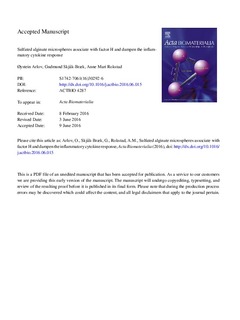| dc.contributor.author | Arlov, Øystein | |
| dc.contributor.author | Skjåk-Bræk, Gudmund | |
| dc.contributor.author | Rokstad, Anne Mari | |
| dc.date.accessioned | 2016-10-03T14:16:27Z | |
| dc.date.accessioned | 2016-10-10T13:58:35Z | |
| dc.date.available | 2016-10-03T14:16:27Z | |
| dc.date.available | 2016-10-10T13:58:35Z | |
| dc.date.issued | 2016 | |
| dc.identifier.citation | Acta Biomaterialia 2016, 42:180-188 | nb_NO |
| dc.identifier.issn | 1878-7568 | |
| dc.identifier.uri | http://hdl.handle.net/11250/2414025 | |
| dc.description.abstract | Alginate microspheres show promise for cell-encapsulation therapy but encounter challenges related to biocompatibility. In the present work we designed novel microbeads and microcapsules based on sulfated polyalternating MG alginate (SMG) and explored their inflammatory properties using a human whole blood model. SMG was either incorporated within the alginate microbeads or used as a secondary coat on poly-l-lysine (PLL)-containing microcapsules, resulting in reduction of the inflammatory cytokines (IL-1β, TNF, IL-6, IL-8, MIP-1α). The sulfated alginate microbeads exhibited a complement inert nature with no induction of terminal complement complex (TCC) above the values in freshly drawn blood and low surface accumulation of C3/C3b/iC3b. Conversely, SMG as a coating material lead to substantial TCC amounts and surface C3/C3b/iC3b. A common thread was an increased association of the complement inhibitor factor H to the alginate microbeads and microcapsules containing sulfated alginates. Factor H was also found to associate to non-sulfated alginate microbeads in lower amounts, indicating factor H binding as an inherent property of alginate. We conclude that the dampening effect on the cytokine response and increased factor H association points to sulfated alginate as a promising strategy for improving the biocompatibility of alginate microspheres. | nb_NO |
| dc.language.iso | eng | nb_NO |
| dc.publisher | Elsevier | nb_NO |
| dc.relation.uri | http://www.sciencedirect.com/science/article/pii/S1742706116302926?np=y | |
| dc.title | Sulfated alginate microspheres associate with factor H and dampen the inflammatorycytokine response | nb_NO |
| dc.type | Journal article | nb_NO |
| dc.type | Peer reviewed | nb_NO |
| dc.date.updated | 2016-10-03T14:16:27Z | |
| dc.source.pagenumber | 180-188 | nb_NO |
| dc.source.volume | 42 | nb_NO |
| dc.source.journal | Acta Biomaterialia | nb_NO |
| dc.identifier.doi | 10.1016/j.actbio.2016.06.015. | |
| dc.identifier.cristin | 1363548 | |
| dc.description.localcode | © 2016. This manuscript version is made available under the CC-BY-NC-ND 4.0 license http://creativecommons.org/licenses/by-nc-nd/4.0/ | nb_NO |
